While both classical and acoustic guitars might seem like siblings at first glance – sharing six strings, a soundhole, and tuning pegs – a closer look reveals they are distinctly different instruments. Understanding these differences is crucial whether you’re a budding musician deciding which guitar to learn on, or an experienced player looking to expand your collection. Let’s dive into the key distinctions between classical and acoustic guitars.
Shape and Body Size
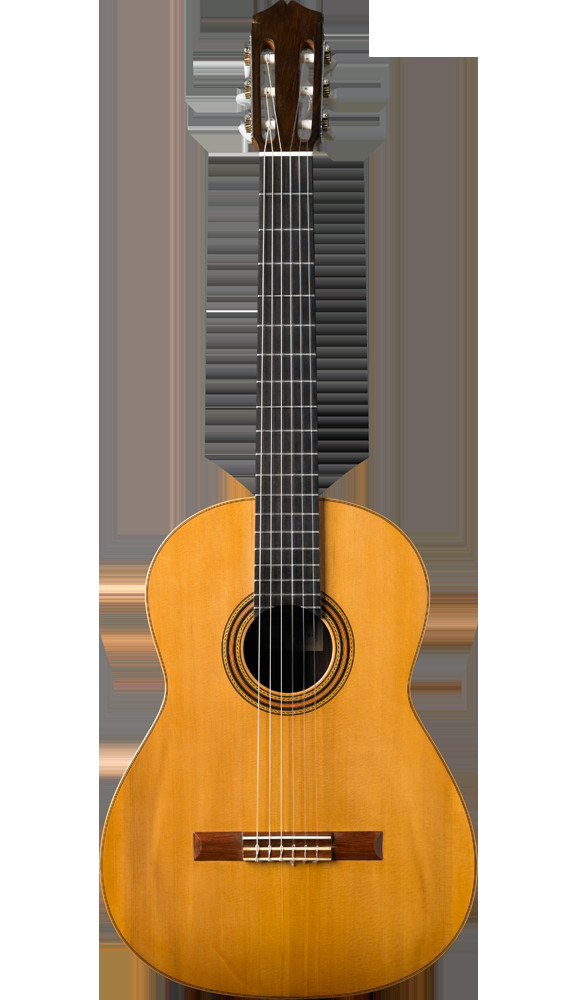 Classical guitar and acoustic guitar body shapes side by side highlighting their size and form differences.
Classical guitar and acoustic guitar body shapes side by side highlighting their size and form differences.
Acoustic guitars are commonly found in the dreadnought shape, a popular design known for its robust sound and larger body. You’ll also encounter parlor-size acoustics, which are generally smaller than classical guitars, though size variations exist across different acoustic guitar manufacturers. Classical guitars typically maintain a more consistent body shape, often slightly smaller than a dreadnought but with a wider lower bout to enhance resonance.
Neck Profile and Fretboard
One of the first physical differences you’ll notice is the neck. Classical guitars are characterized by a wider neck compared to acoustic guitars. This wider neck is designed to accommodate the fingerstyle playing technique central to classical guitar music. The broader string spacing provides more room for the fingers to pluck individual strings cleanly. Furthermore, classical guitar necks are typically flat, whereas acoustic guitar necks can have a slight radius, contributing to different playing feels. It’s also worth noting that classical guitars often lack fret markers on the fretboard face, relying on side markers only, which is a traditional characteristic that some players may find challenging initially.
Bridge Design and String Attachment
The bridge, responsible for anchoring the strings to the guitar body, also differs significantly. Classical guitars utilize a tie-block bridge. Here, the nylon strings are manually tied around the bridge in a knot to secure them. This method is similar to how strings are attached on a ukulele. While traditional tie-on bridges are standard, some classical guitars are designed to accommodate ball-end nylon strings, offering an alternative, perhaps simpler, stringing method. Acoustic guitars, in contrast, use a pin bridge system. Strings are fitted with ball-ends that are held in place by bridge pins inserted into the bridge. This system is designed for the higher tension of steel strings.
Strings: The Defining Contrast
The most fundamental difference, and arguably the heart of their distinct sounds and playing experiences, lies in the strings. Classical guitars are strung with nylon strings, while acoustic guitars use steel strings.
This string choice dictates much of the guitars’ sonic character. Nylon strings are considerably thicker and produce a warmer, mellower, and more resonant sound compared to the bright and ringing tones of steel strings. Classical guitar nylon string sets are constructed with treble strings (G, B, high E) made from solid nylon monofilament, while the bass strings (E, A, D) consist of a nylon multifilament core wound with silver-plated copper. Nylon strings are softer to the touch and have a smooth, almost plastic feel, which many beginners find more comfortable on uncalloused fingertips.
However, the softer sound of nylon strings may not be as prevalent in contemporary popular music. Classical guitars excel in genres like classical, Spanish, and flamenco music, where their warm and nuanced tones are perfectly suited. Conversely, acoustic guitars, with their steel strings, are the workhorse of modern rock, folk, blues, and country music.
Steel strings on acoustic guitars create a bright, crisp, and resonant sound, often described as having a twang. This brighter tone projects further and is generally louder than a classical guitar. Acoustic guitar strings are available in various metals and alloys, including bronze and phosphor bronze, each contributing slightly different tonal nuances. Steel strings are thinner than nylon strings and, while similar in gauge to electric guitar strings, can feel sharper on the fingers, especially for new players.
String Type Deep Dive
Classical Guitar Strings
Ernie Ball offers a range of classical guitar strings designed for different tonal preferences and playing styles.
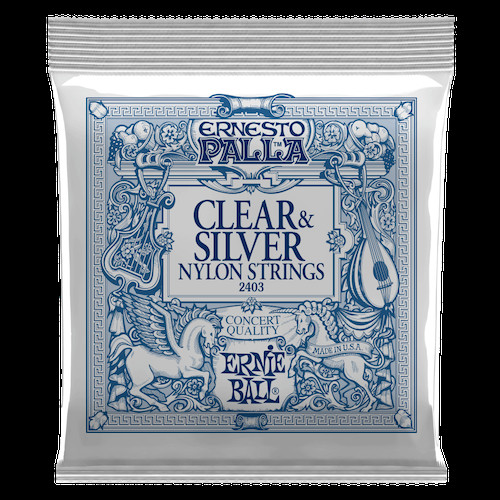 Ernie Ball Ernesto Palla Clear & Silver Nylon Classical Guitar Strings packaging, showcasing the clear nylon and silver winding.
Ernie Ball Ernesto Palla Clear & Silver Nylon Classical Guitar Strings packaging, showcasing the clear nylon and silver winding.
Ernesto Palla Clear & Silver Nylon Classical Guitar Strings: These are among the most popular classical strings, known for their concert quality sound, delivering a smooth, rich tone with exceptional clarity and performance.
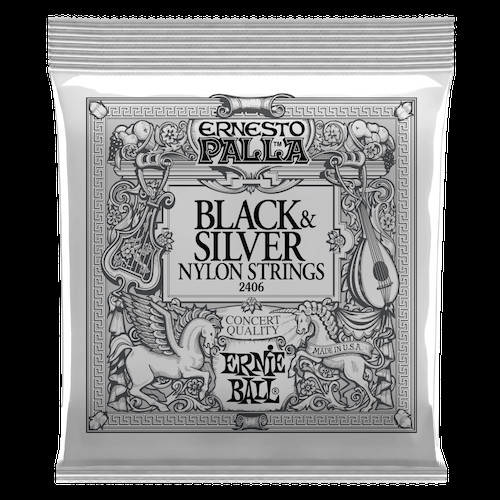 Ernie Ball Ernesto Palla Black & Silver Nylon Classical Guitar Strings packaging, highlighting the black nylon treble strings.
Ernie Ball Ernesto Palla Black & Silver Nylon Classical Guitar Strings packaging, highlighting the black nylon treble strings.
Ernesto Palla Black & Silver Nylon Classical Guitar Strings: Crafted with a different nylon composition, these black nylon strings produce a warmer, purer tone with enhanced treble overtones, favored by many folk guitarists.
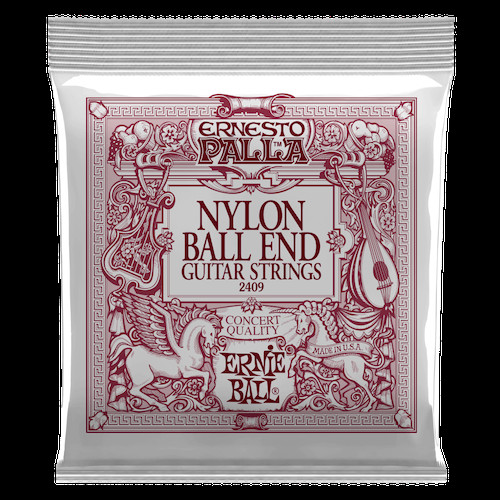 Ernie Ball Ernesto Palla Black & Gold Ball-End Nylon Classical Guitar Strings packaging, showing the ball-end construction and gold windings.
Ernie Ball Ernesto Palla Black & Gold Ball-End Nylon Classical Guitar Strings packaging, showing the ball-end construction and gold windings.
Ernesto Palla Black & Gold Ball-End Nylon Classical Guitar Strings: Featuring gold wound basses made of 80/20 bronze wrapped around a nylon multifilament core, these strings provide a smooth, rich tone and incorporate a ball-end design for quicker and easier string changes compared to traditional tie-end strings.
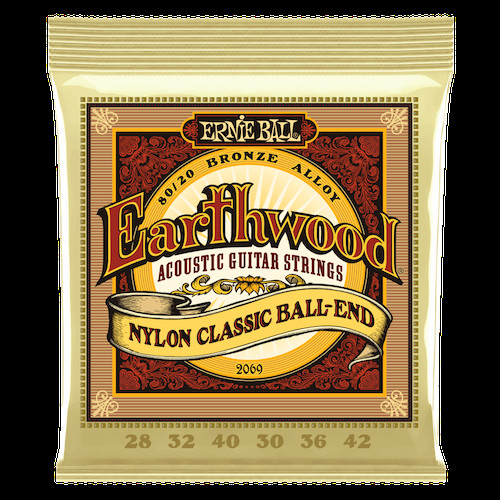 Ernie Ball Earthwood Folk Nylon, Clear & Gold Ball End, 80/20 Bronze Acoustic Guitar Strings packaging, indicating folk nylon and bronze winding.
Ernie Ball Earthwood Folk Nylon, Clear & Gold Ball End, 80/20 Bronze Acoustic Guitar Strings packaging, indicating folk nylon and bronze winding.
Earthwood Folk Nylon, Clear & Gold Ball End, 80/20 Bronze Acoustic Guitar Strings: These strings blend nylon trebles with 80/20 bronze wound basses, delivering rich treble tones with a percussive attack, suitable for folk and fingerstyle playing.
Acoustic Guitar Strings
Ernie Ball also offers a diverse selection of acoustic guitar strings to cater to various playing styles and tonal preferences.
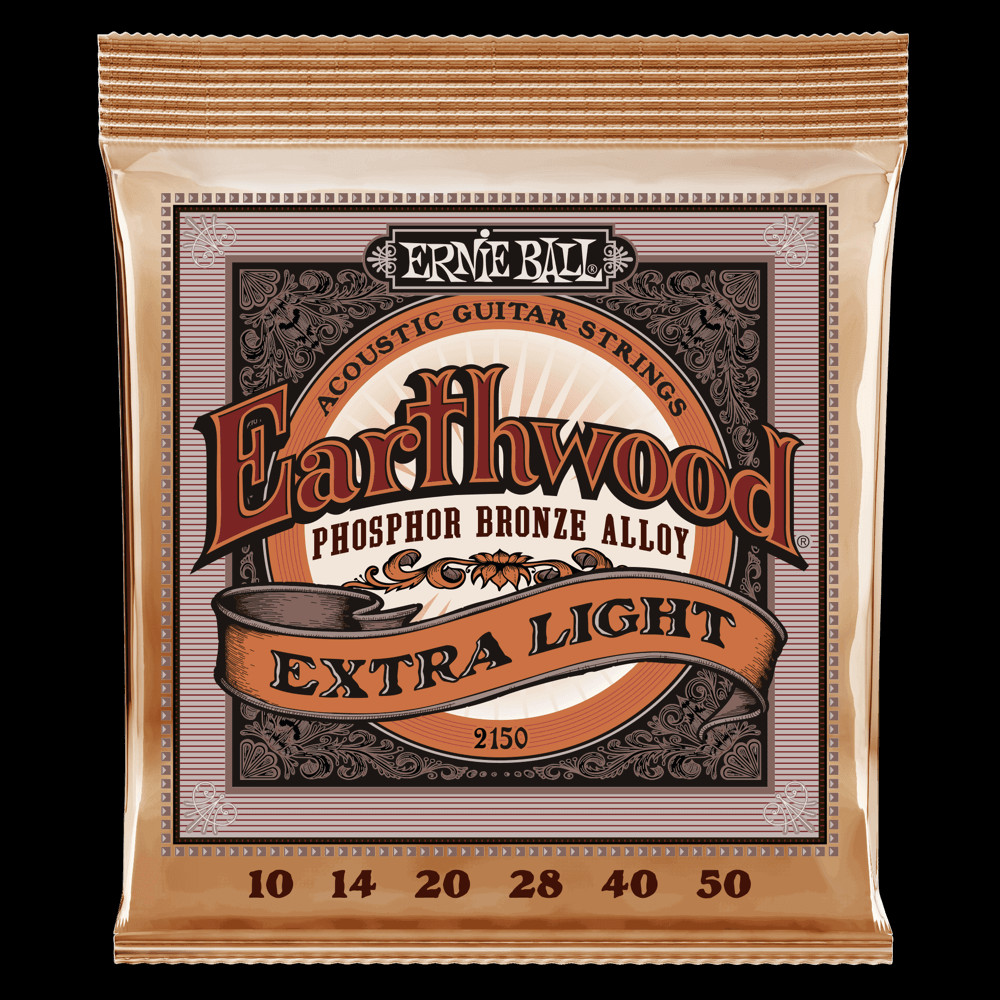 Ernie Ball Earthwood Acoustic Guitar Strings packaging, emphasizing the Earthwood series for acoustic guitars.
Ernie Ball Earthwood Acoustic Guitar Strings packaging, emphasizing the Earthwood series for acoustic guitars.
Earthwood Acoustic Guitar Strings: Available in Phosphor Bronze for a mellow, ringing sound and 80/20 Bronze for crisp, bright overtones, Earthwood strings are a popular choice for acoustic players seeking balanced tone and reliable performance.
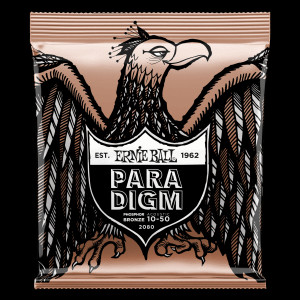 Ernie Ball Paradigm Acoustic Guitar Strings packaging, highlighting the Paradigm series for strength and longevity.
Ernie Ball Paradigm Acoustic Guitar Strings packaging, highlighting the Paradigm series for strength and longevity.
Paradigm Acoustic Guitar Strings: Offered in both 80/20 and Phosphor Bronze, Paradigm strings are engineered for unprecedented strength and extended string life while maintaining the signature Earthwood tone and feel.
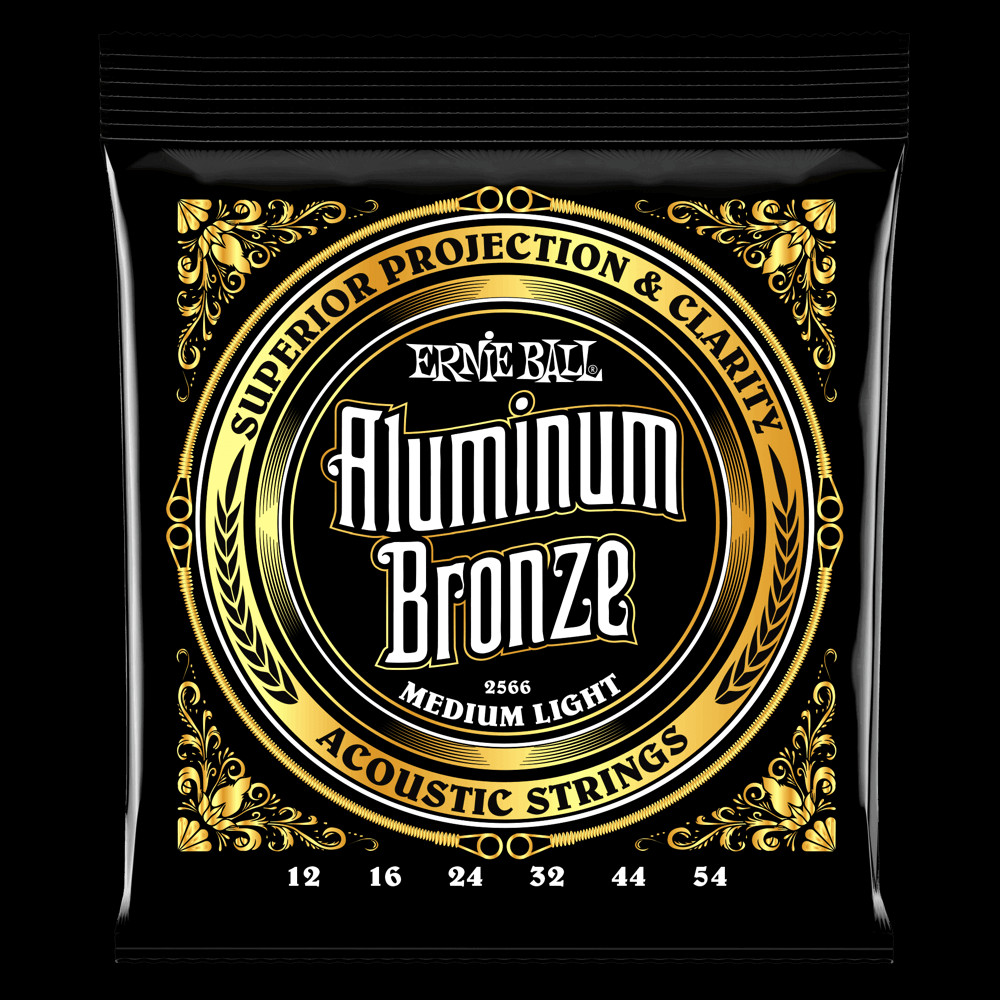 Ernie Ball Aluminum Bronze Acoustic Guitar Strings packaging, indicating aluminum bronze construction for projection and clarity.
Ernie Ball Aluminum Bronze Acoustic Guitar Strings packaging, indicating aluminum bronze construction for projection and clarity.
Aluminum Bronze Acoustic Guitar Strings: These strings provide enhanced projection and clarity compared to traditional bronze strings, along with improved corrosion resistance. The aluminum bronze wrap wire and Maraging Steel hex core contribute to pronounced lows and brilliant highs.
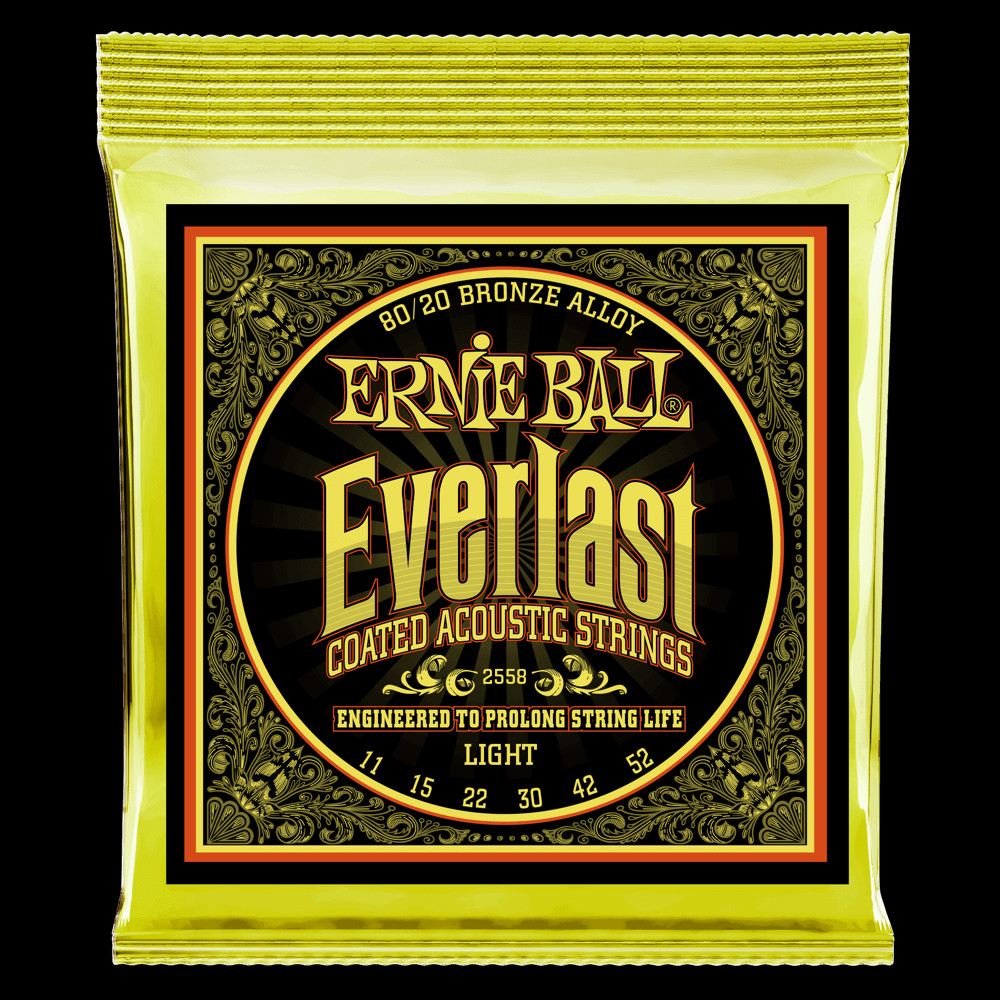 Ernie Ball Everlast Coated Acoustic Strings packaging, showcasing the Everlast coating for extended string life and tone preservation.
Ernie Ball Everlast Coated Acoustic Strings packaging, showcasing the Everlast coating for extended string life and tone preservation.
Everlast Coated Acoustic Strings: Available in 80/20 and Phosphor Bronze versions, Everlast strings utilize nanotechnology coating to repel moisture and oils, preserving tone and extending string life without compromising feel or sound quality.
To hear classical guitar strings in action, check out Steve Morse playing Ernie Ball Ernesto Palla Clear & Silver Nylon Classical Guitar Strings.
In conclusion, while sharing visual similarities, classical and acoustic guitars are distinct instruments designed for different musical styles and playing techniques. The choice between a classical guitar and an acoustic guitar ultimately depends on the sound you’re aiming for and the genre of music you wish to play. Understanding these fundamental differences will guide you in selecting the right guitar to match your musical aspirations.
